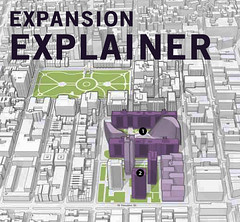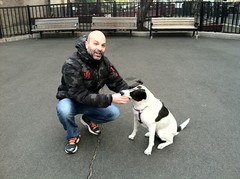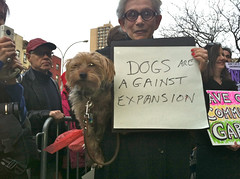As Village residents await Borough President Scott Stringer’s recommendation early next month regarding N.Y.U.’s expansion plans, The Local is taking a look at the impacts of the project. Today, we’re examining the concerns surrounding the replacement of a dog run under the proposed development. Yesterday, we looked at the impact the proposal would have on three playgrounds in Greenwich Village. Check back for our coverage of concerns surrounding loss of light and the LaGuardia Community Garden.
So what does the future hold for the dog run at the corner of Houston and Mercer Streets should N.Y.U.’s expansion be approved?
The dogs and their roughly 300 owners at the Mercer-Houston Dog Run will have to be relocated to make way for the Zipper building, which will be 26 stories at its highest point. The building would extend almost the entire length of the south block along Mercer Street between Houston and Bleecker Streets. In addition to housing, academic, retail space and a hotel, the new structure would also hold the replacement for the Morton Williams Supermarket at the northwest corner of the south block. The university says the replacement grocery store would be fully operational before Morton Williams is demolished in 2018.
So, what will happen to the dogs and their masters?
N.Y.U. has planned a similarly-sized dog run along Houston Street, just west of the existing one. The current run is measured at 3,175 square feet — N.Y.U. says its replacement will be slightly larger at 3,195 square feet. According to the university, the replacement would be open before the current dog run is closed. A protective barrier would also be placed between construction of the Zipper building, which is expected to last 54 months, and the new dog run.
What do members of the dog run object to most about the plan?
According to Beth Gottlieb, president of the Mercer-Houston Dog Run, the replacement run would fall short on two fronts. Ms. Gottlieb argues the new dog run would represent an overall loss of 50 square feet – a number found by an architect who measured the space on behalf of the dog run (a process that involved an automatic laser, according to Ms. Gottlieb). Moreover, the replacement dog run would be located below one of the Silver Towers. “I’m speaking as a dog lover, and if I lived in Silver Towers, would I want a dog run under my home?” said Ms. Gottlieb. “There would be an uproar by tenants and there would be a restriction of hours, or we’d be forced to shut down.” The current run is accessible 24 hours a day, and is not directly below any other buildings.
If dog owners want an alternative run during the 54 months of construction, where would they go?
The nearest dog run is in Washington Square Park. But unlike the Mercer-Houston Dog Run — which charges an annual $60 membership fee and requires a training and orientation period for new members, as well as confirmation of all vaccinations and shots — the Washington Square Park run is open to all dogs.
And if owners want to stay at the new Houston Street run, would the new Zipper building cast a shadow on them?
Yes. According to the University’s Environmental Impact Statement, the dog run “would experience shadow from the proposed Zipper building during the mornings throughout the year, and shadow from the existing University Village towers in the afternoons.” According to dog run members, the current run is exposed to the sun starting around 10:30 a.m. – depending on the season – and is without shadows until sunset.
Would the new dog run also be a membership-only organization?
That has yet to be decided. University Vice President Alicia Hurley pledged to come to a decision after consulting the members of the dog run. Ms. Gottlieb, on the other hand, said that the university has not communicated with them sufficiently so far. “There really never has been good negotiation in good faith with the community,” said Ms. Gottlieb. “No N.Y.U. official has ever raised the question of public-versus-private.”
This post has been revised to reflect the following correction:
Correction: April 2, 2012
An original version of this post incorrectly stated that the training and orientation period at the Mercer-Houston Dog Run is 30 days.







